
by J. Karlin
Send comments, suggestions, additions, etc. to:jk@jktarot.com
1. What is Tarot?
Tarot is a deck of (78) cards, a number of games played with the deck, and a number of metaphysical beliefs and practices attached to the non-gaming use and contemplation of the deck. Tarot was invented as a card game in the early-mid 15th century, most likely by the nobility of north Italian city states. In 1781 two small essays written by a Swiss-born French philosophe and a French cavalry officer provided the basis for all future development of what has come to be known as occult Tarot. Prior to this time little public discussion had occurred concerning the use of Tarot for divination, although much had been written (both for and against the practice) for almost three centuries prior to 1781 about the use of playing cards in divination. The extension of this tradition to Tarot was a natural one, and the main question is when precisely it took place.

2. What does the name Tarot mean, and where did it originate?
It is generally claimed (even by playing-card historians) that no one knows with certainty what the name Tarot means. There are many theories, most connected in some way to hysterical claims about the origin of the deck. The main thing to remember is that Tarot was originally called Trionfi (carte da trionfi—cards with triumphs), the Italian word for Triumphs, or trumps, and referred specifically to the twenty-two trump cards added to the already existing standard playing-card deck of fifty-six cards (this had been imported into Europe from Moslem Egypt in the 14th-century) that enabled one to play the card game of Trionfi. Eventually the Italians started calling the deck and game Tarocchi (tar-ok-kee), and again it is generally believed no one knows for certain why the change occurred nor what exactly Tarocchi means. When the deck entered France, sometime around the turn of the 16th century, the French shortened the Italian name to Tarot, the name by which the deck is known to the English-speaking world. However, if you click the link below, you'll learn about some new-old information that may in fact explain once and for all what Tarot actually means.
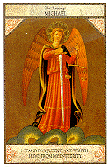
3. Where can I get a Tarot deck?
Where can't you get one?
But what exactly is it you want to get and why? Just a deck of cards? An experience? Something new and pretty to point to on the mantle as it sits gathering dust?
Anyway, those are things you ought to consider, but you want to know where. OK, your best bet these days is the Internet, and good news, it looks like you're already there. Of course you can find Tarot cards in most large bookstores, and certainly in almost any new-age store. But online your choices are much more varied and often less expensive. This website is a very good place to find links to purchase a number of Tarot decks the FAQ author deems worthy of your interest and money. Good luck.

4. What is the history of Tarot?—deck evolution/timeline
Tarot 's history is at the heart (and sometimes the mind) of the considerable hysteria surrounding the entire subject of Tarot. This question is both easily and never answered, because to answer it thoroughly and accurately would be to answer it without prejudice or agenda, and no one seems able to do that or to even come close. For example, Tarot was invented in Italy, not in ancient Egypt as the occultists have claimed. That's a fact. However, an important part of Tarot, the biggest portion of the cards in fact, are closely based on a deck imported into Europe from—Egypt! Not ancient Egypt of course, but Mamluk Egypt. Uh-oh, what's that or them? And you can see the problem. The history of Tarot is unbelievably complicated, yet on the surface the facts seem simple and clear. One thing you learn studying Tarot, and its continuing history. Very little about it is reliably or steadfastly simple and clear.

5. What are the symbolic roots of Tarot?
If all you ever read were occultist or pomo Tarot books that claim to answer this question, you'd just keep chanting to yourself—twenty-two, twenty-two, twenty-two, all the way up to six-sixty-six (actually, up to six-hundred sixty—oh well). The fact and the curse that the deck just happens to have an important structural division of twenty-two parts has parked the car of hysteria securely in the Tarot lot. Why is twenty-two a big deal? There are twenty-two letters in the Hebrew alphabet of course, and that's the basis for the considerable mystical mulch that makes up Kabbalah, and Kabbalah has been the symbolic wellspring for just about every occultist idea people have layered onto the old gaming deck of Tarot. And while in a very dry and factual way this seems pretty silly and falsely established and promoted, even from an historical (not just hysterical) point of view, it might not be too ridiculous to make Tarot a Kabbalistic stepchild.

6. What books should I read to get started or to learn more about Tarot?
I can wholeheartedly (and wholebrainedly) say, since I'm both the author of this FAQ, and the book I'm recommending above all others to you, that if you were to read just ONE book about Tarot, it should be Rhapsodies of the Bizarre. It's not a very large book, and so can't possibly claim to be the most thorough treatment of Tarot, the game or deck of cards. No, that honor and tedium goes to Michael Dummett's bloated and seldom read 1980 The Game of Tarot. Nor is it a super-spooky occultist cosmograph, like Aleister Crowley's excellent The Book of Thoth, although contained within Rhapsodies' pages is the source for every occult-Tarot cosmograph ever written, including The Book of Thoth. The reason you need to read Rhapsodies of the Bizarre, first and foremost and forever, is that it alone will tell you the unvarnished truth about Tarot and the peculiar planet you think you want to visit (or even move to)—Tarotmania.

7. What do the cards mean, if anything?
OK, before we start, let me make an important distinction, that escapes many people as they're learning Tarot and which stays out of their reach till I have to explain it to them—there are two basic kinds of meanings in Tarot:
1. Symbolic meanings (what the symbols on the cards mean individually and as a collective symbol).
AND
2. Divinational meanings (what the cards mean, or how they are read, in fortune-telling).
Because of the way fortune-telling and Tarot dogma developed, being initially different traditions which were fused together by occultists, the two kinds of meanings are often seemingly different and confusingly so. So, if you've already encountered this, that's not just you being stupid—it's a real effect and a real problem, until you've dug a little deeper into what's going on.

8. How do I use a Tarot deck to tell the future'? (includes Keltic Cross explanation)
Oh come now, if people could use Tarot cards to tell the future, they'd be doing it, and if they'd be doing it they'd be running the world, not telling you about it. AND, you sure as hell wouldn't reasonably expect to find out how to do it in some Internet FAQ, now would you? But who said Tarot was reasonable? Well, it can be, but that's another question and answer.
So, I'll tell you what I'll do. I'll tell you how to use a Tarot deck to tell the future. And then I'll tell you how to use a Tarot deck to build a house of cards. And you'll know as much about the future from using your cards to do either of these things.
But, that's not good enough for you, is it? You want to know the future, and you want to use playing cards to look it up. And you demand to be shown how to do it. OK. Just remember you made me do this.

9. What are 'reversals' and how do I get them into my readings?
A long time ago in a galaxy far, far away (called France) this guy named Etteilla, a wouldbe occultist and a surewas scam artist, decided to do card readings with something called a Piquet deck (32 cards, plus, for purposes of reading, a blank card, which our hero modestly named the Etteilla). Etteilla provided TWO different meanings for these cards, one for the normal (or upright) card, and one for when the card would be turned upside-down (that is, with the top inverted to the bottom). The idea was that a card would have both a native divinational meaning or meanings, and also meanings that would reflect a degrading or lessening or reversing of these inherent or natural indications. It is remarkable that people have difficulty getting reversed cards to appear, magically or otherwise, into their decks and readings, but they often do have a problem with this.

10. What's the difference between "reversed cards" and "elemental dignities"?
When you reverse (or Etteilla) a card, you are attempting to supply your deck with some possible alternative meanings, that is, something different from the norm. With reversed cards, what you are going to get is pretty much of an either-or situation, although there are usually several different meanings for both the upright and reversed position. However, there is another way of generating these alternative meanings that does not use reversed positions or meanings at all, and that is a system called elemental dignities, which seeks to analyze a series of cards based on their elemental relationships to each other, and therefore, ALL readings using this method should provide opportunities, without recourse to manual inversions of the cards, to get sometimes very subtle ranges of meaning with all the cards.

11. Can I read my own cards?
Simple answer: YES!
Ignore people who tell you that you'll be too prejudiced to read clearly, or that the energies won't be right or whatever the excuse is supposed to be. You CAN read cards for yourself.
Of course, you're advised to READ the cards, and not merely force them to say what you want, but that advice applies regardless of whether you are reading for yourself or someone else.

12. How is Tarot related to other forms of divination?
The best evidence indicates that fortune-telling with playing cards began quite early, and was adapted to existing systems of divination, such as those used with another popular gambling tool, dice. As cards replaced dice as the game of choice amongst players of jeux de hasard (games of chance), one sees how cards would also come to replace dice as the divinational tool of choice. Indeed, playing cards and dice were seen by 16th- and 17th-century clergy as divinational tools, even in their application for games, since the chance part of the equation implied a divine involvement or an attempt by the gambler to rely upon or invoke this involvement. Fortuna was, after all, a pagan deity. After the occultist adoption of Tarot, some specific similarities between Tarot and astrology were introduced, particularly in the way some systems of Tarot divination are performed. Also, given a certain creativity in the formulation of layouts, Tarot can be made to simulate the superficial structures of all kinds of other systems. For example, one of the most popular reading layouts is the Astrological or Zodiac spread, where each position represents either a sign of the zodiac or a house of a horoscope.

13. How do I use a Tarot deck for contemplation?
Contemplation first involves a preparation and this is largely a mental exercise with Tarot. Fill your mind with as many facts (and thoughts and feelings about the facts as you can)—in other words, learn what the cards mean. In the beginning you will not know much, but that's OK, the more you learn about Tarot, the more productive the contemplation becomes.
When the preparation is done, then you will be ready to exercise this knowledge in myriad forms of contemplation or meditation, which doesn't necessarily take any particular form or function—life is a meditation in this view. However, if you wish to formalize your experience, you can find many guides to teaching you proper breathing and postures by looking to books, newsgroups and websites devoted to yoga.

14. How do I use a Tarot deck to play a game?
Many games have been invented to play with Tarot or Tarocchi. Tarot cards were almost certainly created to play games, not to read fortunes or to represent occult philosophies, so it is with the games of Tarot that one is really using the deck in its oldest and (some would say) purest application.
Numerous variations exist, mostly bridge-like games involving trick-taking.
See Michael Dummett's book, The Game of Tarot, for more explanations of this material than you could probably ever care to read. If you want a relatively brief, but still detailed, account of a particular brand of Tarot game, that played in 18th-century France, see this explanation in Rhapsodies of the Bizarre.
Also, there are some Tarot web sites that include different versions of Tarocchi rules.

15. What about computer Tarot programs?
Well there are some, but one question that frequently comes up concerning computer Tarot is—does it really work?
The answer is no more approachable than is the similar question for Tarot in general. People who tend to distrust computers and technology seem to think that only a human-spirit link can power the Tarot (reading) mechanism. On the other hand, some computer programmers, especially ones who pain themselves about the creation of some perfect randomizing agent (algorithm), also refuse to believe that a computer-generated reading could be as natural as that conducted by a human. This latter concern raises an interesting philosophical point, is the randomization of the cards what we are actually trying to achieve by shuffling? In fact, statistically, most people are not sufficiently skilled shufflers to easily produce a randomized deck, or at least one whose order is greatly changed from the starting one. People clump cards together, shuffle only two or three times, and generally make it pretty likely that they'll reproduce card sequences in their readings—something which has happened to most readers and which is generally seen, without any scientific justification, as quite significant. At least in computer readings, you don't have to worry about all that, some machine, or some software, will shuffle for you. And, in my experience, most online readings are about as useful as most human ones, which is not really a positive comment about computer readings so much as a negative one concerning the reading abilities of most people who tell fortunes with cards.

16. What about those extra 'Magi' in the Thoth Deck?
You know, a lot of things about pomotarot, and the postmodern world of Tarot, are pretty damned stupid. And this is a classic example of one of those things. In fact, this is SO stupid, even the people who think they know what I'm talking about here are about to get quite a shock because—it's even stupider than initiates know.
So, here, for the first time in hystery, is the whole dumb tale of the Thoth Three Magi.

17. What are the ethics, if any, of reading cards?
Well, first of all, we'd better answer the question—What are ethics? After we do that, as simply as we can for starters, we can then consider this question with respect to what is done, and perhaps what shouldn't be done, with Tarot. A set of ethics, particular to a group, is a system of rules governing behavior. It doesn't necessarily have to evoke or recommend moral behavior, at least not in any metaphysical sense, but it does provide a structure for how to behave in a limited human application of morality. In other words, one hopes to use the ethics of a class of humans, in this case card readers, to both better understand the moral assumptions of that class (what they view as good and bad), and at the same time perhaps to mimic that behavior as a way of initiating oneself into the class. Well, that's the theory, and you can already tell, by the drooping of your eyelids, that it's not really a subject that's of much interest to your average fortune-teller. But it is an interesting question, and answer (or discussion). And as you know, if you're interested in more detail—
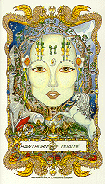
18. Are telepsychics REALLY reading Tarot, or just credit-card numbers?
If you've been keeping up with recent events on this matter of the legitimacy of telepsychics, and particularly the Tarot-reading kind, such as Miss Cleo (does anyone remember her?), you'll know that the legal answer to this question has pretty much uniformly been that telepsychics are frauds and con artists, ONLY concerned about taking money from sadly desperate marks. The problem a lot of people who make a living reading cards have with that answer is that they feel Miss Cleo's (and her bosses') obvious scamming of victims is not a fair reflection of what the average card reader does, even of the ones working as day-trippers for the big scams.

19. What is cold reading?
Have you ever been walking down the street and you saw a person in ragged dirty clothing pushing a shopping cart filled with what appeared to be his personal possessions? And when you saw that person, you came to some conclusion about who (or even what) he was. You did that without reading Tarot cards, without looking at his bank account, without needing to ask him a single thing about his life. You cold read him and concluded, most likely correctly, that he was a homeless person. That doesn't make you a psychic, and it certainly doesn't make you a Tarot reader. It does mean you possess at least an average bit of perception and the ability to discriminate between (not necessarily against) different states of human existence. A good cold reader can take that ability to perceive or coldly read the passive indicators of a human condition and they can make it look like fortune-telling. All the better is this effect promoted or perpetrated if they also happen to be plying this trade with a pack of Tarot cards.

20, What does "Death" REALLY mean?—OR, I just got the Death card, should I go ahead and pay for my funeral expenses?
Death is death. Get it? You will. Now, the answer to this question provides perhaps the clearest illustration of a Tarotic rule: simple answers inevitably veil more complex indications. But, if you're counting on that to get you out of Death, or death, you're out of luck, or rather utterly into luck, which doesn't necessarily mean good luck, does it? The thing is life itself is a series of infinite deaths, infinitely discrete stops or terminations where a mood, a thought, a love or a hate, or a memory, cherished or otherwise—or a life—expires. A breath is a death. And then there is the final breath, the whispered clarion of death. So, death is the fundamental requirement for life, and the meaningful experience of it. Everything we think, do, or care anything about is framed by death, and our sentence of death. It is almost as if life is but an ornament or fruit of death, the peculiarly glittering human stars briefly budding the black tree of death. So, you see, you didn't just get the Death card.
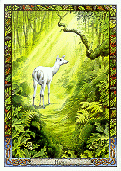
21. Can I (and should I) design my own Tarot deck?
Can you? Sure. While you at it, go design (or doodle) a starship, or a nuclear reactor, or paint the 21st-century Mona Lisa, or write a great novel or just do something really useful with yourself and cure cancer. Because, if you're just starting out with Tarot, or if you've only been at it using the blind-alley affirmation method, you don't have a clue about what you're doing or what Tarot is about. Isn't that correct? So, why do you figure you'd be any good at designing an example of something you know little or nothing about? But, lots of people do figure just that, aiming to reach the heights by expressing the depths of arrogance and absurdity. And they inevitably end up with muck that only vaguely makes sense even to them. The greatest Tarot deck ever designed, the Thoth deck of Aleister Crowley, was the culmination of a long and interesting life spent absorbing and processing huge amounts of symbolic data. Now, that's what we all do of course, process symbolic data. It's just that some of us are artists at it, and those people not only can but SHOULD make Tarot decks (and that doesn't require a pack of cards), and some of us can't process our way out of a wet paper bag, and those people should spectate (not speculate).
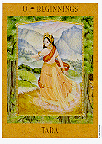
22. What are some online resources I can use to learn more about Tarot?
Well, lucky you, you're already at the best place to do that. And to learn more about Tarot is often to learn things which don't necessarily seem to be about Tarot at all. For example, the oldest Tarots incorporate motifs that have their origins in Renaissance Italian themes of the rebirth of Roman Imperial virtues (and domination) as screened through a Biblical, or even Apocalyptic, filter. So, to truly understand Tarot, you will find yourself needing to study such varied subjects as Roman triumphs and psychomachias and the Biblical mysteria of the Revelation of St. John the Evangelist. Some of you who come to Tarotic studies, or Tarot fortune-telling, hoping to escape the long arm of the Bible and it ministers of shouldn'a-ought'a, are completely out of luck (there's that word again). Tarot is of the Bible, illustrates Biblical themes, and finally permeates Tarotic dogma, which is of course Christian (though sometimes gnostically so) in foundation and expression. Even the darker expressions of Tarot are expressions in (or contra) a Christian context. Aside from these dark and musty vaults of Tarotic archives, there's a living breathing Tarot evolving right before our postmodern eyes, and the web is full of examples of these many derivative species of the old book.
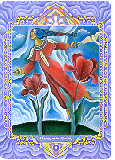
23. Are there alternate Tarot FAQs, ones that will better support my own ignorant feelings?
What—you worry? Perish that bad feeling, dude! Of course there are alternatives to this list of skeptical, sarcastic semantics. And some of them are not only amusingly dim and dense, but are good examples of the promotion of Tarotic-demonic dogma, wherein Tarot, the traditional Devil's Picturebook, is denounced by other religious kooks, i.e. the ones still reading fortunes out of the Bible instead of Tarot, as yet another indication that Satan rules, baby!—well, at least till the AntiSatan comes (back). Anyway, here are some links for finks in search of kinks:
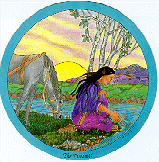
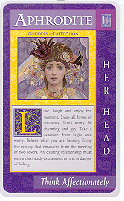
Image source: http://www.learntarot.com/subjar.htm
No comments:
Post a Comment